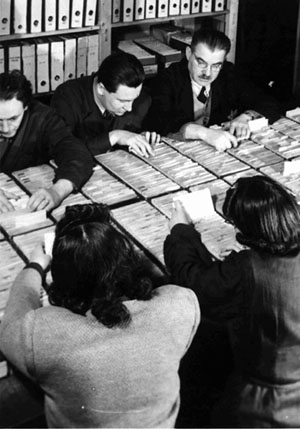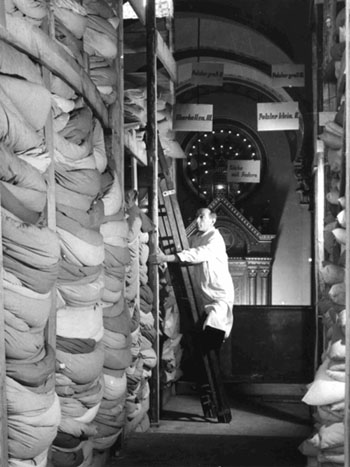From the Nazi occupation onwards, the Jewish communities could no longer be considered voluntary organisations with a religious purpose. The Nazis removed their leading officials and tried to transform them into a tool of anti-Jewish policy. The Jewish communities in the Czech lands were fully subordinated to the Centre for Jewish Emigration in Prague. The officials of the Jewish communities thus found themselves skating on thin ice between helping their members in need and engaging in forced cooperation with the Nazi authorities.
Immediately after the occupation, the two quarrelling tendencies within the Jewish society were reconciled. Czech assimilationists and Zionists agreed to cooperate in leading the Jewish community. The situation was so serious that their earlier disputes seemed insignificant. Representatives of the Jewish communities tried to prevent the worst and attempted to have the Nazis' anti-Jewish measures modified and slowed down. On the other hand, they were forced to share in the implementation of the Third Reich's anti-Semitic policy and were forced to register their members and draw up lists of persons for deportation. It must not be forgotten that the leading officials of the Jewish communities were working under continuous threat of imprisonment and death, and that only a few of them lived to see the end of the war.
During the first years of occupation, the chief goal of the Jewish communities was to provide help to low-income and sick members, and to support emigration. Židovské zprávy (Jewish News), the magazine that the Jewish community had to publish, carried numerous appeals for collections to help the needy. It also printed dozens of articles on opportunities for emigration and how to make use of them, and celebrated the new type of the Jewish manual labourer. To facilitate emigration, above all, the Jewish community in Prague held a large number of training courses, which enabled participants to learn the basics of practical occupations.

Filing room in the Jewish Religious Community in Prague. (Photo: Archive of the Jewish Museum in Prague)
The Jewish communities had to keep a register of all their members. This originally served to facilitate social aid and emigration, but later it had to be used as a basis for deportations. Immediately after the occupation, the Jewish religious communities had to draw up lists of their members' names. In October 1939 the registration of the Jewish inhabitants of the Protectorate was decreed, during which Jews of other faiths than Judaism, or of no faith, were registered for the first time. A total of 80 319 people of Jewish faith and 9 828 Jews who were not of Jewish faith were registered. All those who were not of Jewish faith but to whom the definition of a Jew applied, as defined by the Nuremberg laws, were ordered to make themselves known to the Jewish religious community. The number of Jewish inhabitants registered by name increased from 12 680 to nearly 103 000
From March 1940 on, all Jews and Jewish organisations were subordinated to the Jewish Religious Community in Prague, including people of non-Jewish faith or of no faith. The Jewish community had the task of collecting the special fees and taxes that were imposed on the Jewish population, of helping Jews in need, jointly organising Jewish emigration and later deportation, and fulfilling further orders issued by the Centre and the Gestapo. The Prague community created an extensive bureaucracy around these tasks, employing approximately 2 600 people. Ongoing Aryanisation and the pauperisation of the Jewish population meant the community had a huge task. Most Jews were without paid employment and had to live off their savings, on which they were only allowed to draw to a limited extent, or were reliant on the aid of the religious community. The religious community also performed the function of labour office and organised Jewish labour deployment.
From autumn 1941 on, Jews were banned from holding public religious services. Instead of a religious function, many synagogues now had an entirely different role: they became storage places for Aryanised property. All the confiscated objects had to be carefully classified and catalogued. Objects from defunct synagogues from all over the Protectorate were collected in the Prague Jewish Museum, where they were classified by a group of experts who tried to preserve what little remained of the Jewish communities whose members were deported. Their work was continuously impeded and abused by the Nazis, and museum employees were gradually scheduled for deportation.

Storage of Aryanised objects in the Karlín synagogue. (Photo: Archive of the Jewish Museum in Prague.)
The saddest chapter in the functioning of the Jewish community under Nazi occupation was its shared role in the deportations. From autumn 1941 until spring 1945, the Jewish community had to share in its own liquidation, distribute call-ups for transport and ensure that transport went smoothly. However, the Jewish community did not choose those who were to be included in transport. From the Centre for Jewish Immigration it received about 1 200 to 1 300 card records at a time, from which the community's transport department merely removed those who were for some reason (by dint of having a family member employed by the community, for example) protected from transport. Although deportation was ordered by Nazi bodies, many of those deported saw the Jewish community as the organiser of the deportations. This deception was part of the Nazi policy towards the Jewish communities.
Literature:
-
Hyndráková, Anna, Krejčová, Helena and Svobodová, Jana. Židé v Protektorátu. Hlášení Židovské náboženské obce v roce 1942. Dokumenty (Juden im Protektorat. Berichte der jüdischen Glaubensgemeinschaft 1942. Dokumente). Praha: ÚSD AV ČR - Maxdorf, 1997. 491 p.
-
Lagus, Karel, Polák, Josef and Polák, Karel. Město za mřížemi (Stadt hinter Gittern). Praha: Naše vojsko - SPB, 1964. 365 p.
-
Bondyová, Ruth. Chronik der sich schließenden Tore. Jüdisches Nachrichtenblatt - Židovské listy (1939-1945). Theresienstädter Studien und Dokumente. Prag: Academia, 2000, p. 86-106.
-
Rupnow, Dirk. Ústřední židovské muzeum v Praze 1942 - 1945. Terezínské studie a dokumenty. 2000, p. 278-289.
Odkazy:
-
The story of the Jewish Museum. On the website of the Jewish Museum in Prague. In Czech and English.